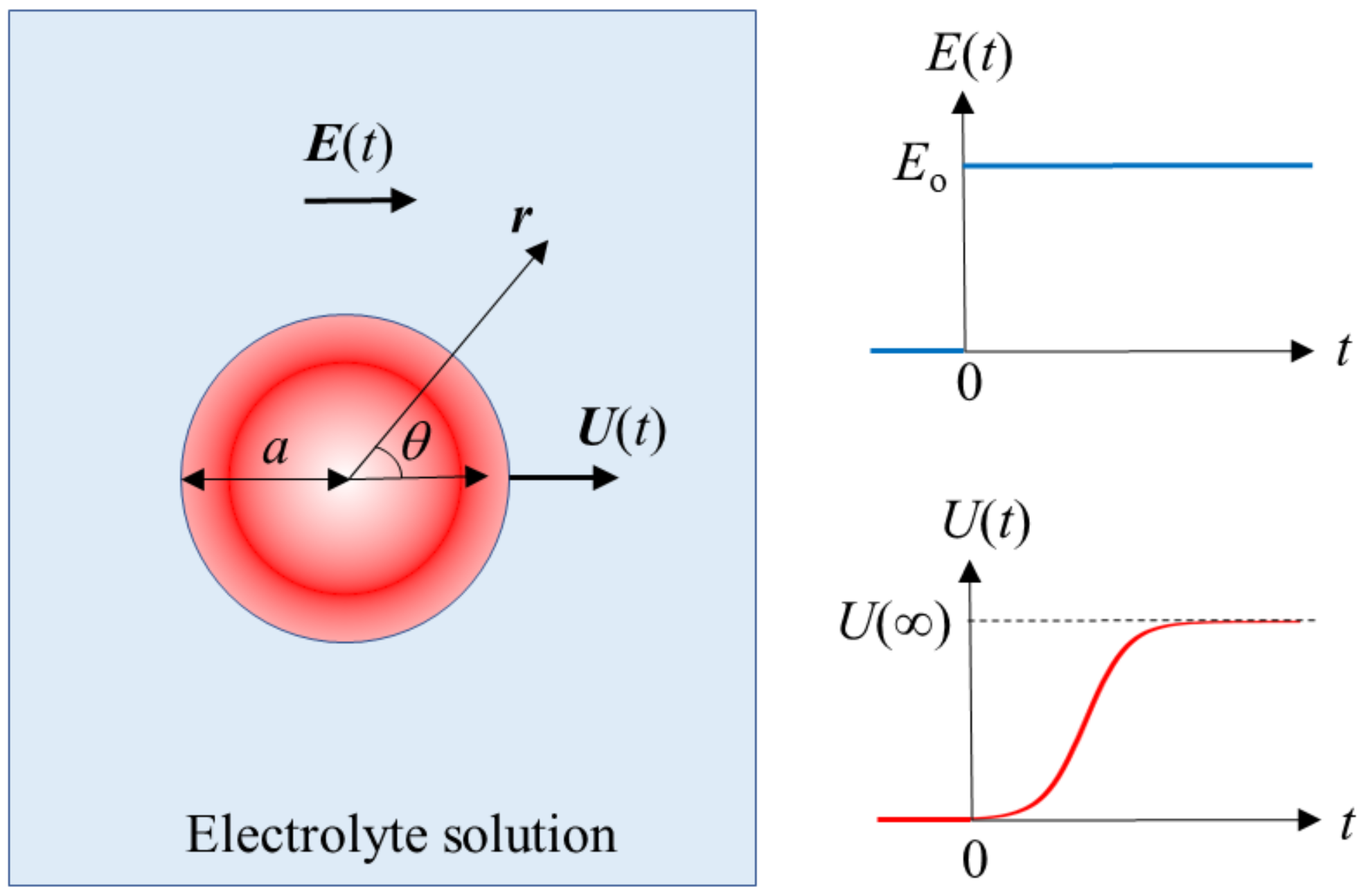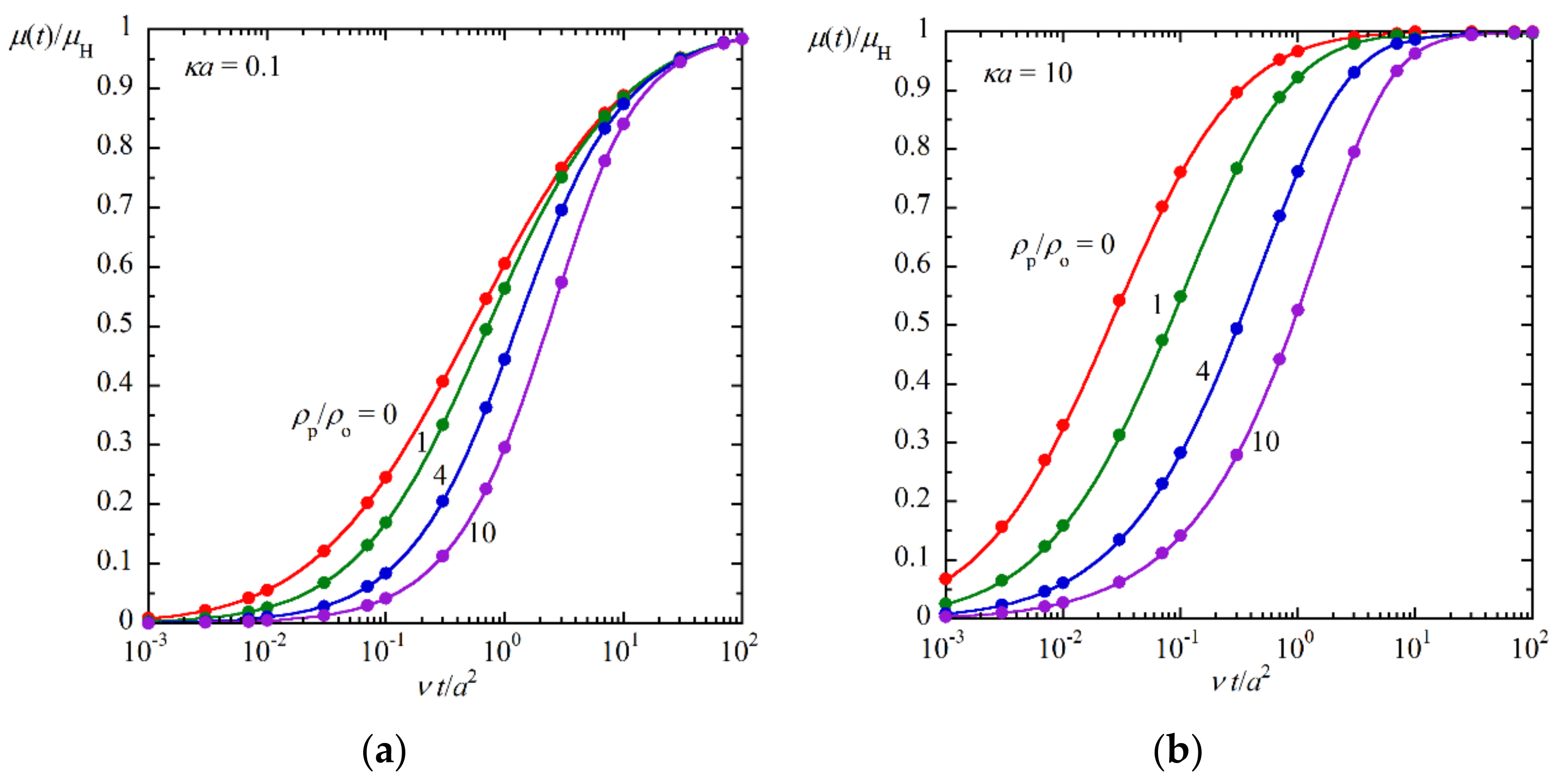2. Theory
Consider a spherical colloidal particle of radius
a, mass density
ρp, and zeta potential
ζ in an aqueous liquid of relative permittivity
εr, mass density
ρo, and viscosity
η that contains a general electrolyte consisting of
N ionic species of valence z
i, bulk concentration (number density)
ni∞, and drag coefficient
λi (
i = 1, 2, …,
N) (
Figure 1). Suppose that at time
t = 0, a step electric field
E(
t) is applied to the particle, viz.,
where
Eo is constant and the particle starts to move with an electrophoretic velocity
U(
t) in the direction parallel to
Eo. The transient electrophoretic mobility
μ(
t) of the particle is defined by
U(
t) =
μ(
t)
E(
t) =
μ(
t)
Eo. The origin of the spherical coordinate system (
r,
θ,
φ) is held fixed at the center of the particle and the polar axis (
θ = 0) is set parallel to
Eo. We treat the case where the following conditions are satisfied: (i) The liquid can be regarded as incompressible. (ii) The applied electric field
E(
t) is weak so that the particle velocity
U(
t) is proportional to
E(
t), and terms involving the square of the liquid velocity in the Navier–Stokes equation can be neglected. (iii) The slipping plane (at which the liquid velocity
u(
r,
t) relative to the particle is zero) is located on the particle surface (at
r =
a). (iv) Electrolyte ions cannot penetrate the particle surface. (v) In the absence of
E(
t), the equilibrium ion distribution obeys the Boltzmann distribution, and the equilibrium electric potential is described by the Poisson–Boltzmann equation.
Under these conditions (1)–(v), the fundamental electrokinetic equations for the liquid flow velocity
u(
r,
t) at position
r(
r,
θ,
φ) and time
t and the velocity
vi(
r,
t) of
i th ionic species—which are similar to those for the dynamic electrophoresis of a spherical particle in an applied oscillating electric field [
17]—are given by
with
where
e is the elementary electric charge,
k is the Boltzmann constant,
T is the absolute temperature,
εo is the permittivity of a vacuum,
p(
r,
t) is the pressure,
ρel(
r,
t) is the charge density, and
ψ(
r,
t) is the electric potential. Equations (2) and (3) are the Navier–Stokes equation and the equation of continuity for an incompressible flow (condition (i)), where the term
ρo(
u·∇)
u has been omitted (condition (ii)). The term involving the particle velocity
U (
t) in Equation (2) arises from the fact that the particle has been chosen as the frame of reference for the coordinate system. Equation (4) expresses that the flow
vi(
r,
t) of the
i th ionic species is caused by the liquid flow
u(
r,
t) and the gradient of the electrochemical potential
μi(
r,
t), given by Equation (7), in which
is a constant term. Equation (5) is the continuity equation for the
i th ionic species of concentration
ni(
r,
t). Equation (8) is the Poisson equation.
The following boundary conditions at the particle surface (at
r =
a) and far from the particle (
r → ∞) must be satisfied:
where
=
r/
r (
r = |
r|) and
is the unit normal outward from the particle surface. Equation (10) states that the slipping plane (at which
u(
r,
t) =
0) is located on the particle surface (condition (iii)). Equation (11) can be derived from the equation of motion of the particle, as in the case of dynamic electrophoresis [
17]. Equation (12) follows from condition (iv). Equation (13) follows from the fact that the electric potential
ψ(
r, t) tends to the potential of the applied electric field
E(
t) as
r →∞.
For a weak field
E(
t), the deviations of
nj(
r, t),
ψ(
r, t), and
μj(
r, t) from their equilibrium values (i.e., those in the absence of
E(
t)) due to the applied field
E(
t) are small. In this situation, we may write
where the quantities with superscript (0) refer to those at equilibrium and
is a constant independent of
r. We assume that the equilibrium concentration
obeys the Boltzmann distribution and the equilibrium electric potential satisfies the Poisson–Boltzmann equation (condition (v)), viz.
with
where
y(
r) is the scaled equilibrium electric potential, and
κ is the Debye–Hückel parameter (1/
κ is the Debye length).
By substituting Equations (14)–(16) into Equation (2), and neglecting the products of the small quantities, we obtain
and form Equations (4) and (5)
Furthermore, symmetry considerations permit us to write
where
E(
t) is the magnitude of
E(
t), and
h(
r, t),
ϕi(
r,
t), and
Y(
r,
t) are functions of
r and
t. By substituting Equations (23)–(25) into Equations (21) and (22), we obtain the following equations for
h(
r),
ϕi(r), and
Y(
r):
where
is a differential operator.
G(
r,
t) is defined by
and
is the kinematic viscosity. The boundary conditions (Equations (9)
–(13)) are rewritten as those for
h(r, t),
ϕi(r, t), and
Y(r, t), as follows:
The transient electrophoretic mobility
μ(
t) can be obtained from Equation (34), viz.,
Here,
h(
r,
t) is the solution to Equation (26), which is most easily solved by using the Laplace transformation with respect to time
t. The Laplace transforms
,
, and
of
h(
r,
t),
G(
r,
t), and
μ(
t), respectively, are given by,
and the Laplace transform of Equation (38) is
Thus, the Laplace transform of Equation (26) gives
By solving Equation (43) and using Equation (40), we obtain the following general expression for
:
The transient electrophoretic mobility μ(t) can be obtained by the numerical inverse transform of Equation (44).
3. Results and Discussion
Equation (44) is the required expression for . The transient electrophoretic mobility μ(t) can be obtained from Equation (44) by the numerical inverse transform method.
Now, consider the low
ζ potential case. In this case, Equations (27) and (28) yield
Then, Equation (30) becomes
The Laplace transform
of
G(
r,
t) is given by
where the equilibrium electric potential
ψ(0)(
r) for the low
ζ potential case is given by
which is obtained from the linearized Poisson–Boltzmann equation ∆
ψ(0)(
r)=
κ2ψ(0)(
r) (see Equation (18)). By substituting Equation (47) into Equation (44), we obtain
which agrees with Huang and Keh’s result (Equation (31) in ref. [
7]). Huang and Keh [
7] obtained the transient electrophoretic mobility
μ(
t) by using the numerical inverse transform of Equation (49). This method, however, involves tedious numerical calculations and is not very convenient for practical uses. The reason for this is that the integration in Equation (49) cannot be carried out analytically due to the presence of the factor 1 +
a3/2
r3. In order to avoid this difficulty, we employ the same approximation method as used for the static electrophoresis problem [
18]. We first note that the integrand in Equation (49) has a sharp maximum around
r =
a +
δ/
κ,
δ being a factor of order unity. This is because the electrical double layer (of thickness 1/
κ) around the particle is confined in the narrow region between
r =
a and
r ≈
a + 1/
κ. Since the factor (1 +
a3/2
r3) in the integrand of Equation (49) varies slowly with
r as compared with the other factors, one may approximately replace
r in the factor (1 +
a3/2
r3) by
r =
a +
δ/
κ and take it out before the integral sign, viz.,
In a similar problem in static electrophoresis [
18], we have found that the best approximation can be achieved if
δ is chosen to be 2.5/
. We use this choice of
δ in the transient electrophoresis problem. By using this approximation, the integration in Equation (49) can be carried out analytically to give
with
Equation (52) has been found to be an excellent approximate expression for the exact expression of Henry’s static mobility formula [
18], viz.,
where
is the exponential integral of order
n. Note that in the limit of
t →∞,
μ(
t) approaches the static electrophoretic mobility
μH and Equation (53) can be derived directly from Equation (49), viz.,
which yields Equation (53), that is,
μ(∞) =
μH.
The transient electrophoretic mobility
μ(
t) can now be obtained analytically from Equation (51) without recourse to the numerical inverse Laplace transformation. The result is
with
where
q1 and
q2 may be either real or complex (
μ(
t) is always real), and erfc(
z) is the complementary error function, defined by
and
M(
z) tends to 0 as
z → 0 and to 1 as
z → ∞.
The transient electrophoretic mobility
μ(
t) given by Equation (56) tends to the correct limiting mobilities for large
κa and small
κa. In the limit of large
κa (
κa » 1), Equation (56) tends to
which agrees with Morrison’s result (Equation (32) in ref. [
1]). In the opposite limit of small
κa (
κa « 1), Equation (55) tends to
which agrees with Keh and Huang’s result (Equation (44) in ref. [
6]).
In order to see the accuracy of Equation (56), in
Figure 2, we compare the approximate results calculated by Equation (56) with the exact numerical results obtained by Huang and Keh [
7] for several values of the ratio
ρp/
ρo for two values of
κa (
κa = 0.1 and 10). The agreement between the approximate results (Equation (56)) and the exact numerical results [
7] is found to be excellent agreement with negligible errors. (Both results agree with each other within the line width.)
Finally, it should be mentioned that there is a simple correspondence between the Laplace transform
of the transient electrophoretic mobility
μ(
t) and the dynamic electrophoretic mobility
μD of a spherical particle under an oscillating electric field of frequency
ω (see the original work by O’Brien [
19] as well as ref. [
17]). The dynamic mobility
μD of a spherical particle of radius
a is given by Equation (83) in ref. [
17], viz.,
with
where
G(
r) is the same as Equation (46). In Equation (63), by replacing -
iω with
s and
G(
r) by
G(
r)/
s, then Equation (63) becomes Equation (49) (and thus Equation (51)).







